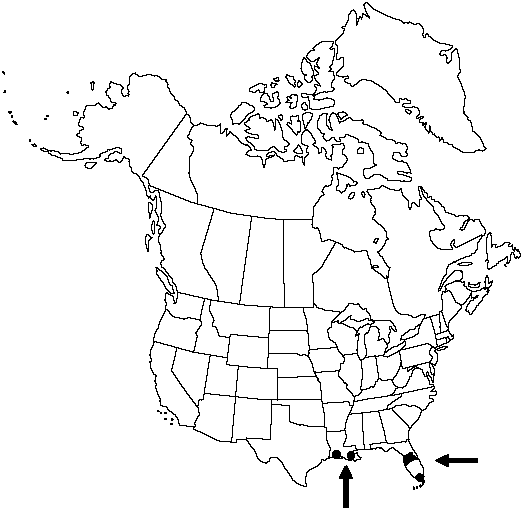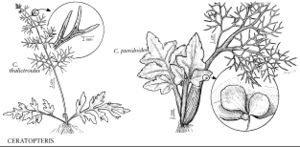Difference between revisions of "Ceratopteris pteridoides"
Bot. Jahrb. Syst. 34: 561. 1905.
FNA>Volume Importer |
FNA>Volume Importer |
||
| Line 22: | Line 22: | ||
}}<!-- | }}<!-- | ||
| − | --><span class="statement" id="st- | + | --><span class="statement" id="st-undefined" data-properties=""><b>Plants </b>floating or rooted. <b>Sterile</b> leaves deltate to cordate to ovate. <b>Petiole</b> of sterile leaf 1–19 cm, usually inflated, in some near base, but in most inflated nearer blades. <b>Blade</b> of sterile leaf 2–4-pinnate, 5–33 × 4–29 cm, simple and palmately 3-lobed (ternate), or pinnately 5-lobed or pinnate near base; proximal pinnae or veins of lobes usually opposite. <b>Fertile</b> leaves deltate to cordate to reniform, 9–50 × 8–36(–50) cm. <b>Petiole</b> of fertile leaf 4–25 cm. <b>Blade</b> of fertile leaf 1–4-pinnate; terminal segments narrow, linear. <b>Sporangia</b> usually crowded between segment midvein and revolute margin, with 0–10(–40) indurate annulus cells. <b>Spores</b> 32 per sporangium, 70–100 µm diam. <b>2n</b> = 78.</span><!-- |
-->{{Treatment/Body | -->{{Treatment/Body | ||
| Line 51: | Line 51: | ||
|publication year=1905 | |publication year=1905 | ||
|special status= | |special status= | ||
| − | |source xml=https://jpend@bitbucket.org/aafc-mbb/fna- | + | |source xml=https://jpend@bitbucket.org/aafc-mbb/fna-data-curation.git/src/9216fc802291cd3df363fd52122300479582ede7/coarse_grained_fna_xml/V2/V2_494.xml |
|genus=Ceratopteris | |genus=Ceratopteris | ||
|species=Ceratopteris pteridoides | |species=Ceratopteris pteridoides | ||
| − | |||
| − | |||
| − | |||
| − | |||
| − | |||
| − | |||
| − | |||
| − | |||
| − | |||
| − | |||
| − | |||
| − | |||
| − | |||
| − | |||
| − | |||
| − | |||
| − | |||
| − | |||
| − | |||
| − | |||
| − | |||
| − | |||
| − | |||
| − | |||
| − | |||
| − | |||
| − | |||
| − | |||
}}<!-- | }}<!-- | ||
-->[[Category:Treatment]][[Category:Ceratopteris]] | -->[[Category:Treatment]][[Category:Ceratopteris]] | ||
Revision as of 13:22, 27 July 2019
Plants floating or rooted. Sterile leaves deltate to cordate to ovate. Petiole of sterile leaf 1–19 cm, usually inflated, in some near base, but in most inflated nearer blades. Blade of sterile leaf 2–4-pinnate, 5–33 × 4–29 cm, simple and palmately 3-lobed (ternate), or pinnately 5-lobed or pinnate near base; proximal pinnae or veins of lobes usually opposite. Fertile leaves deltate to cordate to reniform, 9–50 × 8–36(–50) cm. Petiole of fertile leaf 4–25 cm. Blade of fertile leaf 1–4-pinnate; terminal segments narrow, linear. Sporangia usually crowded between segment midvein and revolute margin, with 0–10(–40) indurate annulus cells. Spores 32 per sporangium, 70–100 µm diam. 2n = 78.
Habitat: Aquatic to semiaquatic, in swamps, bogs, canals, ponds, lakes, ditches, marshes
Elevation: 0–25 m
Distribution

Fla., La., West Indies, Central America, South America, se Asia in Vietnam.
Discussion
Ceratopteris pteridoides is usually easily recognized by its sterile leaf morphology, which varies considerably with habitat. Leaves intermediate between sterile and fertile are fairly common, with various degrees of laminar development of the fertile segments. Some fertile leaves have quite broad segments with rows of sporangia along the margins only. Ceratopteris pteridoides is sexual and diploid and is incompletely reproductively isolated from the diploid C. richardii. Hybrids synthesized by L. G. Hickok (1977) result in 40% viable spores.
Selected References
None.
